

Special Exhibition Commemorating
the 1200th Anniversary of Saichō’s Death
Buddhist Art of the Tendai School
Exhibition Period:
8 February 2022 (Tue) – 21 March 2022 (Mon)
Venue:
Special Exhibition Hall (3rd floor)
Opening Hours:
09:30–17:00 (Tuesdays–Sundays; last admission at 16:30)
Closed:
Mondays (open on 21 March)
Admission Fees:
Adults—1,900 yen
University and High School Students—1,200 yen
Junior High School and Elementary School Students—800 yen
University and High School Students—1,200 yen
Junior High School and Elementary School Students—800 yen
Advance Online Tickets:
Adults—1,700 yen
University and High School Students—1,000 yen
Junior High School and Elementary School Students—600 yen
Group tickets are not available for this exhibition.
Tickets include entry into the Cultural Exchange Exhibition on the fourth floor.
For discounted tickets, please present personal identification documents that reflect your birth
date, such as your passport, health insurance card, or driver’s license at the exhibition hall
entrance upon request.
Admission is free for the following
persons:
Tickets:
Online reservations for tickets are now open via ARTNE (English interface available), PIA, and eplus. Tickets can also be purchased from Lawson’s convenience stores (L-code: 84006), 7-Eleven convenience stores, and FamilyMart convenience stores. Discounted tickets will be available for purchase until 7 February 2022, after which visitors may still purchase tickets for the full price at the abovementioned websites and locations, in addition to the ticketing counters on the first floor of the museum. To prevent overcrowding at the ticketing counters, we recommend that visitors purchase tickets online prior to their visit.
List of Works:
Special Arrangements for COVID-19
- We request that all visitors wear masks when visiting the museum. We also reserve the right to turn away visitors with a fever of 37.5°C or higher, as well as visitors exhibiting cold-like symptoms.
- Please note that exhibition details are subject to change depending on the COVID situation. Please check our website for the latest updates.
Exhibition Overview and Highlights
Saichō (767–822) was the founder of the Tendai school of Buddhism in Japan. As a priest, he had traveled all over Japan to propagate the Lotus Sutra, which preaches that all beings possess the buddha nature, and thus all have the potential to attain Buddhahood. On the occasion of Saicho’s 1200th death anniversary in 2021, retrace the steps he took on his journey in search of enlightenment and learn more about the spread of the Tendai school as you peruse some of the National Treasures and Important Cultural Properties passed down in shrines and temples connected to the Tendai school.
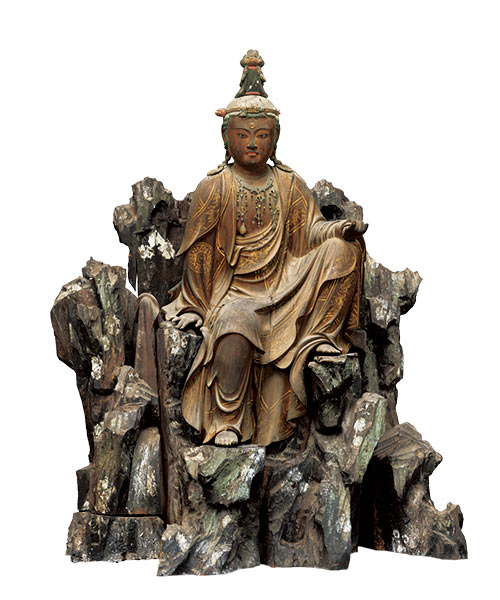
Bodhisattva, purportedly Cintāmaṇicakra
Kamakura period, 13th century
Tōmyōji Temple, Ehime

Tarō-ten with two attendants
Important Cultural Property
Heian period, dated 1130
Chōanji Temple, Ōita

Reproduction of the interior of the Konpon Chūdō
The Konpon Chūdō is the main hall of Enryakuji Temple, the first and central temple of the Tendai school. The hall has been designated a National Treasure, and its interior is being reproduced in our exhibition for visitors to enjoy. Visitors can take photographs of the reproduction display.
Part 1: Saichō and the Roots of Tendai Buddhism
Tendai (Ch. Tiantai) Buddhism was first established in China by a Sui-dynasty (581–618) priest named Zhiyi, who based its teachings on the Lotus Sutra. It gained a foothold in Japan after Japanese monk Saichō who, having studied Zhiyi’s teachings, established Enryakuji Temple on Mt. Hiei. In this section, we take a look at Saichō’s eventful life as told by historical artifacts.

Dengyō Daishi (Priest Saichō)
Important Cultural Property
Kamakura period, dated 1224
Kannonji Temple, Shiga
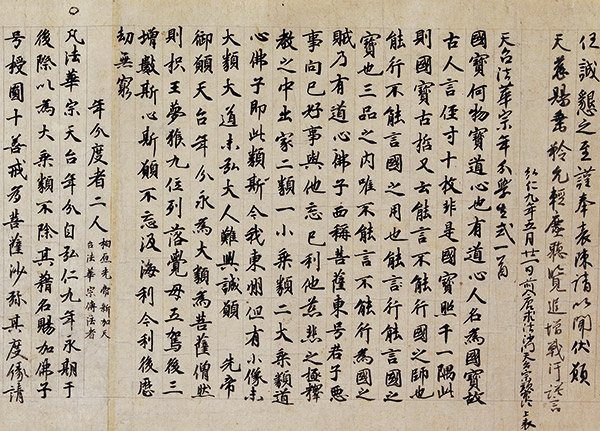
Essential Teachings for Tendai Lotus Sect Priests
By Saichō
National Treasure
Heian period, 9th century
Enryakuji Temple, Shiga
Exhibition period: 8–27 Feb
Part 2: Saichō’s Disciples
Two of the most prominent of Saichō’s disciples were Ennin (794–864) and Enchin (814–91), who later went on to succeed him. Both traveled to the Tang Chinese capital of Chang’an to gain a deeper grounding in Esoteric Buddhism, which Saichō had himself studied in China. They subsequently established the foundations of Tendai Esoteric Buddhism. This section covers the development of the Tendai school in Japan after incorporating elements from Esoteric Buddhism.
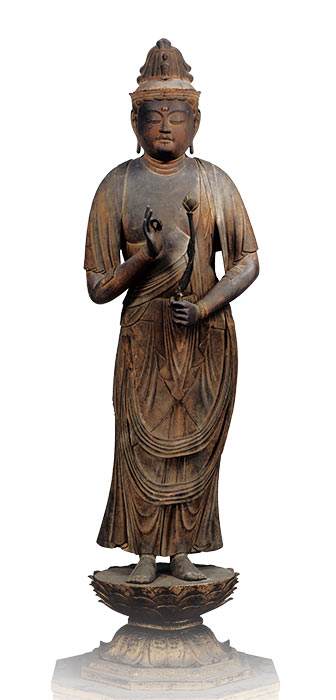
Āryāvalokiteśvara
Important Cultural Property
Heian period, 12th century
Enryakuji Temple, Shiga
Part 3: The Spread of Tendai Buddhism in Japan
Tendai Buddhism places great emphasis on the central idea that the path to enlightenment is open to everyone, a doctrine that formed the basis for its propagation throughout Japan. The exhibits in this section offer a glimpse into the blossoming of Tendai Buddhism across the country.

Shōkū Shōnin (Priest Shōkū)
By Keikai
Important Cultural Property
Kamakura period, dated 1288
Engyōji Temple, Hyōgo
Part 4: Tendai Art and the Nobility
In the mid-tenth century, Enryakuji was restored by priest Ryōgen (912–85) after a series of fires destroyed much of the complex. Following this, Ryōgen led the temple and the Tendai school to new heights, with devoted spiritual and economic patronage of the emperor and the powerful Fujiwara clan. This section features Tendai treasures associated with the religious devotion of the nobility, whose patronage and academic exchange with monks have shaped Japanese Buddhism.

Rokudō-e (The Six Paths)
National Treasure
Kamakura period, 13th century
Shōjuraikōji Temple, Shiga

Śākyamuni Rising from His Golden Coffin
National Treasure
Heian period, 11th century
Kyoto National Museum
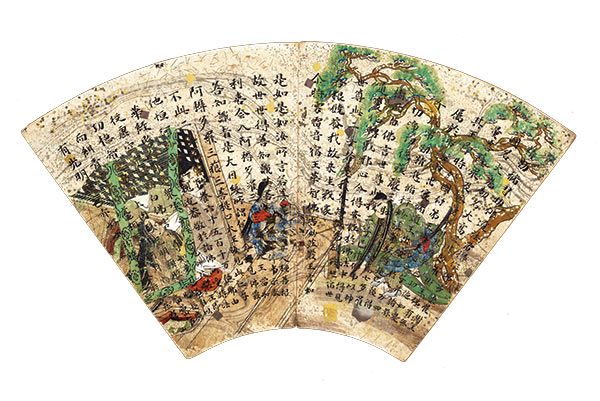
Fan-shaped booklet of the Lotus Sutra
National Treasure
Heian period, 12th century
Tokyo National Museum

Sutra box with hōsōge flower designs
National Treasure
Heian period, dated 1031
Enryakuji Temple, Shiga
Part 5: Diverse Cultures Engendered by Tendai Thought
As Buddhist thought permeated the Japanese consciousness, the Lotus Sutra and its doctrine of universal salvation inspired Hōnen (1133–1212), Shinran (1173–1263), Nichiren (1222–82), and other priests to found several new schools that became collectively known as New Kamakura Buddhism. This section examines how the teachings of the Lotus Sutra led to the blossoming of a rich variety of Tendai schools during Japan’s medieval period.
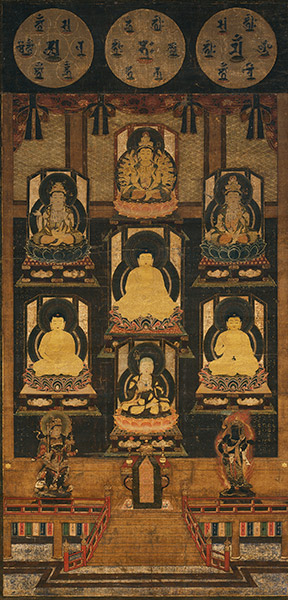
Mandala of Hie Sannō Shrine Honjibutsu (Shintō gods as Buddhist deities)
Important Cultural Property
Kamakura period, 14th century
Enryakuji Temple, Shiga
Part 6: Tendai Buddhism in the Edo Period
In 1571, Enryakuji was razed to the ground by Oda Nobunaga, though it was later restored by Toyotomi Hideyoshi and the Tokugawa shogunate. Playing a pivotal role in the temple’s restoration was Tenkai (1536?–1643), a priest who had served under the Tokugawa shogunate. In this last section, we explore the history of Tendai Buddhism in the Edo period (17th–19th century) through resplendent treasures produced during that time under the patronage of the Tokugawa shogunate.

Jigen Daishi (Priest Tenkai)
Important Cultural Property
Edo period, 17th century
Enryakuji Temple, Shiga
Some exhibits will be rotated throughout the course of this exhibition.
